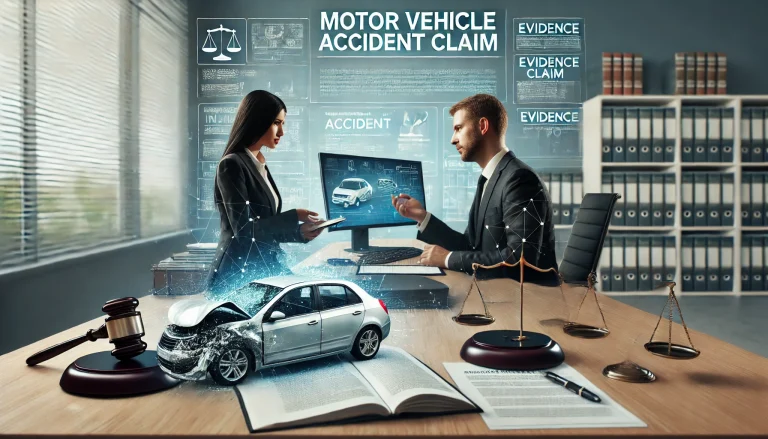Being involved in a car accident is never a pleasant experience. It can be overwhelming and stressful, especially when dealing with injuries, vehicle damage, and insurance companies. However, knowing how to file a motor vehicle accident claim can make the process smoother and help you get the compensation you’re entitled to.
Experts at Affinity Lawyers emphasize the importance of timely filing and thorough documentation. According to their legal team, “The first few steps after an accident—such as gathering evidence and notifying your insurer—are crucial to ensuring the claim is processed efficiently and fairly.”
In this guide, we’ll walk you through the key steps to take, from documenting the accident scene to negotiating with your insurance provider, so you can navigate the process with confidence
1. Ensure Everyone’s Safety First
Before thinking about claims or insurance, your primary concern should be safety. If you or anyone involved in the accident is injured, call emergency services immediately. Even in minor accidents, it’s a good idea to call the police so they can document the incident, which can be critical for your claim.
If it’s safe to do so, move vehicles to the side of the road to avoid further collisions.
2. Gather Information at the Scene
To successfully file a claim, you’ll need to provide thorough documentation. Immediately after the accident, collect the following:
- Personal Information: Exchange names, contact details, and driver’s license numbers with the other driver(s) involved.
- Insurance Information: Get the other driver’s insurance company and policy number.
- Vehicle Details: Write down the make, model, year, and license plate numbers of all vehicles involved.
- Witnesses: If there are any witnesses, ask for their contact information. They can provide an unbiased account of the accident.
- Photos and Videos: Take clear photos and videos of the accident scene, vehicle damage, road conditions, and any visible injuries. These visuals can be very helpful in establishing what happened.
3. Call the Police and File a Report
Even if the accident seems minor, having a police report can be invaluable for your claim. The report provides an official account of the incident and may include crucial details, such as whether any traffic laws were violated or which party is at fault. Be sure to request a copy of the police report for your records and future reference during the claims process.
4. Contact Your Insurance Company
Once the accident is documented and everyone is safe, contact your insurance company to report the incident. Most insurance providers have a specific time frame within which you need to file a claim, so it’s best to notify them as soon as possible. Be ready to provide the following information:
- Details about the accident (date, time, and location)
- A description of what happened
- The information of the other driver(s) involved
- Photos and videos you’ve taken
- A copy of the police report, if available
5. Understand Your Coverage
Before filing the claim, it’s essential to understand what your insurance policy covers. Some key aspects include:
- Liability Coverage: This covers damages you cause to others, including property damage and injuries.
- Collision Coverage: This covers the cost of repairs to your vehicle after an accident.
- Medical Payments or Personal Injury Protection (PIP): This covers medical expenses for you and your passengers.
- Uninsured/Underinsured Motorist Coverage: If the other driver doesn’t have insurance, or their insurance isn’t enough to cover your losses, this type of coverage can step in.
Understanding your coverage will help manage your expectations of what your insurance can provide.
6. File the Claim
Now that you have all the necessary information and have notified your insurance company, it’s time to file the claim. You can typically do this over the phone, online, or through your insurance provider’s mobile app. Be sure to include all the relevant documents and information. Some important steps to expect during this process:
- Claims Adjuster Assignment: Your insurance company will assign a claims adjuster to assess the damages, review the documentation, and determine the payout.
- Repairs and Estimates: The adjuster will likely ask you to get estimates from auto repair shops or they might suggest one. Some insurers even have partner shops they prefer to work with, which can expedite the process.
- Medical Assessments: If you’re filing for personal injuries, you may be required to visit a specific doctor or specialist to assess the extent of your injuries.
7. Track the Claim’s Progress
Once your claim is filed, stay in regular communication with your insurance adjuster. If you’re unsure about the status of your claim, don’t hesitate to ask for updates. Most insurance companies provide online portals or apps where you can track the progress of your claim.
8. Handle Disputes or Denials
If your claim is denied or the compensation offered seems too low, you have options. First, ask your adjuster for an explanation in writing. If you believe the settlement isn’t fair, you can negotiate with your insurer. Make sure to provide any additional evidence that supports your case.
If the dispute can’t be resolved, you might consider hiring a lawyer or contacting your state’s insurance department for assistance.
9. Repair Your Vehicle and Handle Medical Bills
Once your claim is approved, your insurance company will either pay the repair shop directly or reimburse you for the cost. For medical bills, your insurer may cover expenses based on your policy and state laws. Be sure to save all receipts and invoices related to the accident, as you may need them to finalize your claim.
Final Thoughts
Filing a motor vehicle accident claim doesn’t have to be a daunting process. By staying organized, gathering the right information, and communicating clearly with your insurance company, you can make the process smoother. Always remember that your safety and health come first—ensure you take the right steps following an accident to protect yourself, your passengers, and your financial interests.

